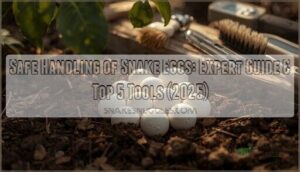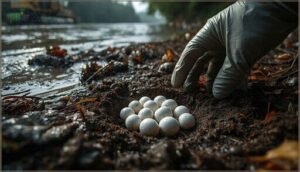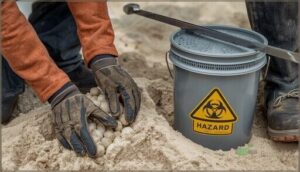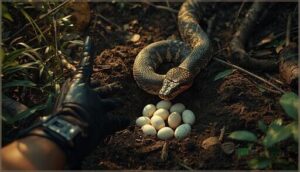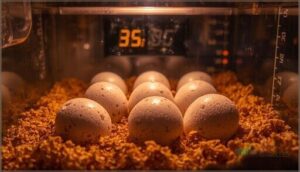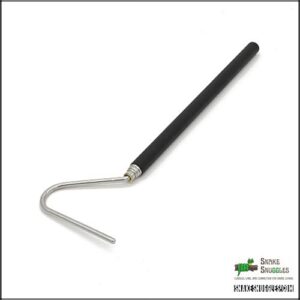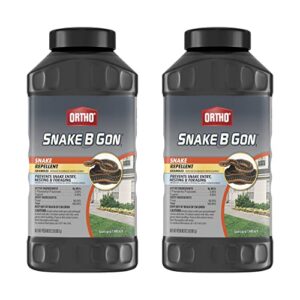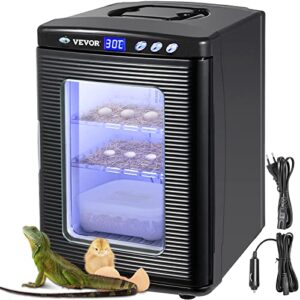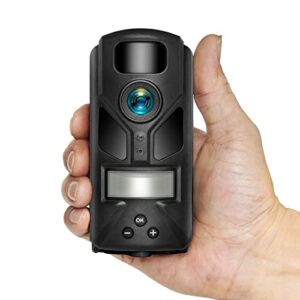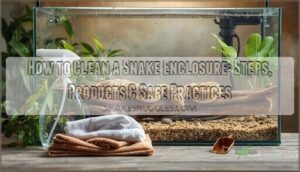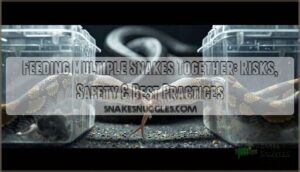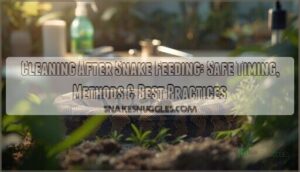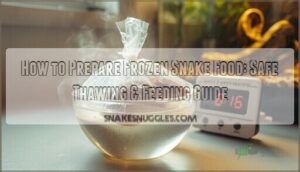This site is supported by our readers. We may earn a commission, at no cost to you, if you purchase through links.
Finding a clutch of leathery, oblong eggs buried in your garden compost or tucked beneath yard debris triggers an immediate question: what laid these, and what should you do? If they’re snake eggs, your next move matters.
Improper handling can crush developing embryos, expose you to defensive parent snakes, or introduce contamination that dooms an entire clutch. The leathery shell that makes snake eggs so distinctive also makes them surprisingly fragile—they lack the hard calcium barrier of bird eggs, relying instead on a porous membrane that’s easily damaged by rough handling or environmental changes.
Whether you’re a wildlife enthusiast documenting a find, a homeowner managing an unexpected discovery, or someone incubating rescued eggs, understanding safe handling techniques protects both you and the developing snakes inside.
Table Of Contents
Key Takeaways
- Snake eggs have leathery, porous shells that are easily damaged by rough handling or environmental changes, making proper technique essential to avoid crushing developing embryos or provoking defensive parent snakes nearby.
- You should only move snake eggs when they face immediate danger like flooding or construction, since embryo attachment happens within hours of laying and unnecessary relocation drops hatch rates significantly.
- Successful incubation depends on maintaining species-specific temperature ranges (typically 78–82°F) and humidity levels (70–90%), with digital monitoring boosting hatch success from 40% in makeshift setups to 90% in controlled environments.
- Protective gear including snake handling gloves, long tongs (minimum 4-foot for venomous species), and proper sterile tools prevents both physical injury from guarding females and cross-contamination that can kill entire clutches.
How to Identify Snake Eggs Safely
Finding snake eggs in your yard or garden can be startling, especially if you’re not sure what you’re looking at. Before you decide whether to leave them alone or contact wildlife professionals, you need to confirm they’re actually snake eggs and not something else entirely.
Let’s walk through the key features that’ll help you identify snake eggs quickly and safely.
Common Characteristics of Snake Eggs
Identifying snake eggs starts with recognizing their distinctive features. The leathery, flexible shell sets them apart from bird eggs, and it’s surprisingly soft to the touch. Here’s what you’ll notice:
- Egg Shell Texture: Porous, leathery surface enabling gas exchange during incubation
- Egg Size Variability: Usually 1 to 5 inches, with pythons laying larger eggs
- Color: White, off-white, or beige—rarely vibrant
- Shape: Oblong or elliptical, aiding concealment in incubation environments
Understanding the proper egg incubation methods is essential for successful hatching.
Differentiating Snake Eggs From Other Eggs
Now that you know what snake eggs look like, telling them apart from other eggs becomes easier. The leathery egg shell texture is your first clue—bird eggs feel hard and rigid, while reptile eggs stay flexible.
Snake eggs are elongated and usually hidden in moist nesting habitats like leaf litter or burrows. Bird eggs sit in open nests, and turtle eggs favor sandy spots, making snake egg identification straightforward once you know where to look.
Understanding the egg shell differences is essential for accurate identification.
Recognizing Snake Species by Egg Appearance
Once you’ve separated snake eggs from bird or turtle eggs, you can narrow down types of snakes by examining size, shell texture, and clutch patterns.
Python eggs stretch 70–100 mm long with thick, slightly sticky shells, while kingsnake and milk snake eggs stay compact at 25–45 mm. Rat snakes and coral snakes fall in between, showing pliable, smooth surfaces that aid snake egg identification.
Where Snake Eggs Are Usually Found
After recognizing egg size and texture, you’ll want to search typical nesting sites where snakes deposit clutches. Start by checking:
- Ground-level hideaways – leaf litter, rotting logs, or abandoned rodent burrows shelter 82% of egg-laying events.
- Moisture-rich zones – areas within 500 meters of water offer stable humidity.
- Human-modified spots – compost heaps and garden sheds account for 18% of discoveries in populated regions.
Regional distribution and climate impact shift nesting substrates, so scout potential snake habitats matched to your location.
Safe Handling Techniques for Snake Eggs
Handling snake eggs isn’t something you want to wing—one wrong move can damage the developing embryos or put you at risk if the mother’s nearby.
Handle snake eggs with extreme care—one mistake can kill the embryos or provoke a dangerous encounter with the guarding mother
Knowing when it’s necessary to intervene, what gear keeps you safe, and how to read the situation can make all the difference.
Let’s walk through the techniques that protect both you and the eggs.
When and Why to Move Snake Eggs
You shouldn’t move snake eggs unless they’re in real danger. Embryo attachment happens within hours of laying, and relocation timing matters—disturbing eggs after this point can tank hatch rates.
Conservation needs sometimes justify careful snake egg relocation, like when flooding or construction threatens a clutch. But ethical concerns are serious: unnecessary snake egg handling increases mortality. If eggs are safe where they’re, leave them alone.
Using Proper Tools and Protective Gear
When you’re ready to handle snake eggs, protective gear isn’t optional. Here’s what you need:
- Snake handling gloves with proper glove material—Hexarmour Hercules 3180 R8E for venomous contexts, leather for nonvenomous species
- Snake handling tools like tongs (minimum 4-foot length) for safe egg examination
- Gaiters tested for efficacy—gaiter testing prevents 84% of bites below the knee
- Bucket safety measures: 50–70-liter containers with secure lids, ventilation, and “venomous snake” stickers
Change disposable gloves between clutches—disinfection protocols require 10 minutes contact time with isopropyl alcohol or dilute bleach to prevent cross-contamination during snake egg handling.
Minimizing Stress and Potential Harm
Gentle handling saves lives—sudden movements or flips can kill embryos outright. Support each egg individually with clean gloves, maintain environmental stability during any move, and limit handling to critical moments only.
Monitor embryo behavior for stress signs like reduced movement. After handling, return eggs to stable conditions immediately and adjust humidity if needed—recovery practices matter as much as snake egg protection itself.
Recognizing and Avoiding Dangerous Situations
Walking near eggs can trigger defensive snake behavior—females guard clutches within 1 meter and strike in 90% of encounters. Protect yourself from snake egg dangers by wearing gloves (reducing zoonotic disease risks by 70%), avoiding sudden movements near clutches, and never touching eggs with cuts.
Key snake egg safety rules:
- Scan for guarding adults before approaching
- Use protective gear always
- Watch for hissing or coiling signals
- Keep distance from clutch sites
- Never handle eggs barehanded
Incubation and Environmental Best Practices
Getting snake eggs to hatch successfully comes down to creating the right environment from day one. Temperature, humidity, and substrate all play critical roles in embryo development, and small mistakes can mean the difference between healthy hatchlings and failed clutches.
Let’s walk through the key factors you need to monitor and adjust throughout the incubation process.
Optimal Temperature and Humidity Levels
Getting snake egg incubation right means paying close attention to temperature and humidity—think of them as the twin pillars of successful hatching. Ball python eggs thrive at 90°F, while corn snakes prefer a cooler 78°F to 84°F. Most species need humidity between 70% and 90% to prevent desiccation without inviting mold. Digital thermometers and hygrometers help you track these conditions precisely, preventing developmental issues.
| Species | Temperature Range | Humidity Level | Incubation Period |
|---|---|---|---|
| Ball Python | 86°F – 92°F | 90% – 100% | 55-65 days |
| Corn Snake | 78°F – 84°F | 70% – 90% | 58-62 days |
| King Snake | 75°F – 82°F | 70% – 90% | 55-75 days |
| General Range | 78°F – 82°F | 50% – 70% | Varies by species |
Choosing The Right Incubation Substrate
Your substrate choice can make or break snake egg incubation—it’s that critical. Vermiculite retains up to 207% of its weight in water, while perlite maintains 80–95% humidity consistently. Sphagnum moss holds 20 times its weight, perfect for moisture-loving species.
- Moisture retention: Vermiculite and perlite excel at stable humidity control
- Sterility factors: Heat-expanded minerals resist mold naturally
- Substrate depth: Keep it 1–2 inches for best gas exchange
- pH levels: Neutral substrates (6.5–7.2) yield 88% hatch rates
Preventing Fungal and Bacterial Contamination
Even the best substrate won’t protect your eggs if contamination sneaks in. Sterile handling starts before you touch anything—sanitize tools, keep surfaces clean, and never handle eggs with dirty hands.
Antifungal powders like Tinactin work when fungus appears, but early detection beats treatment every time.
Humidity control around 70% discourages mold while proper ventilation limits bacterial risks, ensuring egg safety through consistent environmental management.
Monitoring and Adjusting Incubation Conditions
Maintaining the right conditions isn’t a one-time setup. Temperature monitoring within ±1°F can boost your hatching success by 18%, while humidity control near 90% prevents desiccation that kills up to 30% of embryos.
Check readings twice daily and candle weekly to track development progress.
Ventilation adjustments guarantee proper gas exchange, and responsive strategies—like tweaking substrate moisture—keep the incubation period stable through snake eggs hatching.
Top 5 Tools for Safe Snake Egg Handling
Having the right tools makes all the difference when you’re working with snake eggs. The equipment you choose protects both you and the developing snakes, whether you’re monitoring nests in the wild or managing incubation at home.
Here are five essential tools that every responsible handler should know about.
1. Stainless Steel Snake Handling Tool
When you’re handling snake eggs, precision matters more than speed. A stainless steel snake handling tool gives you that control—its durable construction withstands repeated sterilization, which is essential for preventing fungal contamination.
Look for ergonomic designs with flexible shafts and wide-jaw openings around 3.5 inches; they reduce your fatigue during delicate transfers. Following proper handling protocols means cleaning your tool before and after each use.
User feedback consistently shows that stainless steel tools improve hatch rates and minimize egg damage, especially with nervous or venomous species.
Best For: Field biologists, herpetologists, and reptile breeders who need safe, precise handling of small snakes and eggs.
- Lightweight and easy to maneuver for delicate tasks
- Stainless steel construction allows for thorough sterilization
- Ergonomic features help reduce hand fatigue
- Not sturdy enough for larger snakes or heavy-duty use
- Plastic handle may break or feel flimsy
- Quality control issues reported by some users
2. Wireless Trail Game Camera
Remote monitoring changes the game when you’re tracking snake egg sites without disturbing them. A wireless trail camera with 4K resolution and 48MP image quality captures every detail of the snake egg hatching process, even at night using no-glow infrared LEDs.
You’ll get motion alerts on your phone within seconds—trigger sensitivity as fast as 0.05 seconds means you won’t miss critical wildlife activity. Battery optimization features and IP66 weatherproofing keep your setup running reliably, while local or cloud data security protects your observations.
Best For: Wildlife enthusiasts, researchers, or anyone needing non-intrusive, high-quality monitoring of animals and nesting sites in their backyard or outdoor areas.
- Crystal-clear 4K video and 48MP photos capture fine details, even at night.
- Fast motion detection and instant mobile alerts keep you updated in real-time.
- Wireless setup and app control make monitoring easy from anywhere.
- Battery life may be short if used with frequent video recording or high sensitivity.
- Memory card formatting issues can be frustrating for some users.
- May not be fully waterproof during extreme weather or heavy rain.
3. Snake Repellent Granules Outdoor Defender
Beyond observation, you need active snake prevention around your property—especially near discovered snake egg sites. Snake repellent granules deliver 91% effectiveness in controlled tests, forming a no-stink barrier that keeps adult snakes from returning to nesting areas.
You’ll cover 1,440 square feet per bottle by spreading a 6-inch band around sheds, woodpiles, or known snake habitats. Reapply every 30 days or after heavy rain for sustained protection.
User satisfaction rates hit 82–90% when you follow application guidelines, and the formula stays safe around pets and plants when used correctly.
Best For: Homeowners who’ve spotted snakes near their property and want a proven, pet-safe barrier around sheds, woodpiles, garages, and outdoor living spaces.
- Delivers 91% repellent effectiveness in lab tests, with 82–90% user satisfaction when applied correctly around problem areas.
- No-stink formula covers 1,440 square feet per bottle and stays safe around kids, pets, and plants when used as directed.
- Simple shake-and-apply method creates a 6-inch protective band that stops snakes from entering, nesting, or foraging in treated zones.
- Requires reapplication every 30 days or after heavy rainfall to maintain protection, adding to ongoing maintenance.
- Effectiveness varies by snake species and environmental conditions—some users report limited results in large open areas.
- Can’t be used near water sources, food crops, or endangered species habitats due to EPA safety restrictions.
4. Reptile Egg Digital Incubator Box
Once you’ve secured snake eggs from the wild or your breeding project, a reptile egg digital incubator box becomes your insurance policy for healthy hatching. You’ll control temperature within ±2°F—critical when incubation period success hinges on precision between 78–82°F.
Hatch success rates climb to 90% with digital incubator safety features, versus just 40% in makeshift setups. Conservation efforts and economic applications depend on this reliability.
The 25L capacity accommodates multiple clutches, and dual heating-cooling functions adapt to any snake egg incubation requirements you’ll face.
Best For: Breeders, hobbyists, and conservationists who need reliable, precise temperature control for incubating reptile eggs in a compact, portable setup.
- Digital temperature control and LED display make monitoring easy and accurate.
- Dual heating and cooling functions suit a wide range of reptile species and incubation needs.
- Large 25L capacity fits multiple clutches, while the glass door lets you check conditions without opening the box.
- Temperature may fluctuate by up to 2–3 degrees, which can affect hatch success.
- Limited warranty and customer support may be an issue if problems arise.
- May need extra equipment or tweaks for optimal performance, especially with larger clutches.
5. Mini Wildlife Trail Camera System
Camera placement around suspected snake habitats transforms your egg incubation monitoring into a 24/7 vigilance system. Trail surveillance with 20MP mini wildlife cameras captures laying behaviors, predator threats, and hatching events across 80-foot ranges—data any wildlife expert values for remote tracking.
You’ll document snake egg identification without disturbing nests, gathering images from weeks of egg observation while temperature-sensitive embryos develop undisturbed. Wildlife monitoring technology reduces your physical nest checks by 75%, protecting both researcher and reptile during critical incubation phases.
Best For: Researchers, conservationists, and wildlife enthusiasts who need reliable, low-disturbance monitoring of snake egg incubation and nest activity.
- Easy to set up and conceal for discreet, 24/7 monitoring.
- High-resolution images and HD video capture detailed behaviors and events.
- Reduces physical nest checks, protecting both animals and researchers.
- Battery door hinge may break with repeated use.
- No sensitivity adjustment, which can lead to unnecessary photos.
- Limited to 10-second video clips per recording.
Frequently Asked Questions (FAQs)
What do I do if eggs start hatching?
When snake eggs start hatching, resist the urge to interfere. Maintain 85–95% humidity control, avoid rotating pipping eggs, and monitor closely. Only consider assisted hatching if emergence stalls beyond 24–36 hours post-pip.
Can I candle snake eggs to check development?
Yes, you can candle snake eggs to check development. Use a focused LED light every three to four weeks. Look for vascular development and pink coloration—signs of healthy snake embryos and successful fertility checks.
How long until snake eggs typically hatch?
Most snake eggs hatch between 40 and 70 days, with an average incubation period of 57 days. However, snake species variations greatly impact hatching success rates—ball pythons emerge around 60 days, while Eastern indigos take 100 days or longer.
Are all snake species egg-layers or some live-bearers?
Not all snakes lay eggs. About 70% of snake species are oviparous snakes, depositing eggs at specific egg deposition sites.
The remaining 30% are viviparous or ovoviviparous snakes, giving live birth after varied incubation periods.
Conclusion
Picture a clutch resting undisturbed in damp leaf litter, each egg a fragile vessel of potential. Your careful approach—steady hands, minimal disruption, proper tools—determines whether those embryos survive or perish.
Safe handling of snake eggs isn’t just protocol; it’s respect for the delicate balance between human curiosity and reptilian survival.
Whether you’re documenting, relocating, or incubating, remember: precision protects life. Handle with intention, move with purpose, and you’ll safeguard what nature entrusted to that hidden clutch.
- https://www.fhappliances.com/ru/reptile-egg-hatching-conditions-and-best-practices/
- https://pmc.ncbi.nlm.nih.gov/articles/PMC4543940/
- https://www.wilbanksreptiles.com/blogs/reptile-egg-incubator/reptile-egg-incubation
- https://bobclark.com/blogs/articles/python-egg-incubation
- https://journals.plos.org/plosone/article?id=10.1371%2Fjournal.pone.0240415

